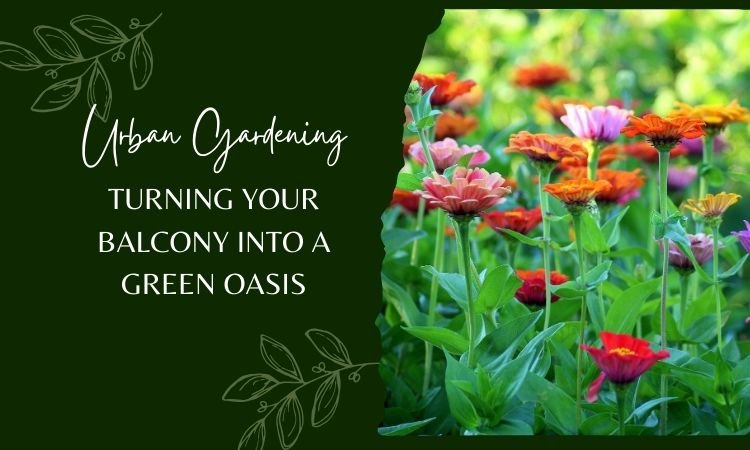In today’s fast-paced urban environment, finding a connection with nature can be challenging. However, one of the most rewarding ways to bring a slice of nature into your home is through urban gardening, specifically transforming your balcony into a lush green oasis. This not only enhances the aesthetic appeal of your living space but also provides a serene retreat from the hustle and bustle of city life. In this blog, we’ll explore the steps and tips to create your own urban garden on your balcony.
Benefits of Urban Gardening
1. Mental Well-being
Gardening has been proven to reduce stress, improve mood, and promote overall mental well-being. The presence of greenery and the act of nurturing plants can provide a sense of accomplishment and tranquillity.
2. Environmental Impact
Urban gardening contributes to a healthier environment by increasing green spaces, reducing the urban heat island effect, and promoting biodiversity. It also helps in reducing air pollution and improving air quality.
3. Fresh Produce
Growing your own herbs, vegetables, and fruits ensures a fresh supply of organic produce. This not only enhances the quality of your meals but also reduces your carbon footprint by decreasing the need for store-bought produce.
4. Space Utilization
Balcony gardening is an excellent way to utilize limited urban space efficiently. It transforms unused or underutilized areas into vibrant, productive spaces.
Steps to Transform Your Balcony into a Green Oasis
1. Assess Your Space
Start by evaluating the size and orientation of your balcony. Consider factors such as sunlight exposure, wind conditions, and available space for plants. This will help you choose the right plants and layout for your garden.
2. Choose the Right Plants
Selecting the right plants is crucial for a successful urban garden. Consider the following plant types based on your balcony’s conditions:
Sun-loving plants: If your balcony receives plenty of sunlight, opt for plants like tomatoes, peppers, and herbs like basil and rosemary.
Shade-tolerant plants: For balconies with limited sunlight, choose plants like lettuce, spinach, and herbs such as mint and parsley.
Compact varieties: Space-saving plants like dwarf fruit trees, cherry tomatoes, and compact herbs are ideal for small balconies.
Ornamental plants: Add aesthetic appeal with flowering plants like petunias, marigolds, and geraniums.
3. Plan Your Layout
Creating a well-thought-out layout maximizes space and enhances the visual appeal of your balcony garden. Consider the following tips:
Vertical gardening: Utilize vertical space with hanging planters, wall-mounted pots, and trellises for climbing plants. This is perfect for small balconies.
Container gardening: Use a variety of containers like pots, troughs, and window boxes to create a diverse and dynamic garden. Ensure they have proper drainage to prevent waterlogging.
Tiered arrangements: Arrange plants in tiers or steps, with taller plants at the back and shorter ones at the front. This provides easy access and ensures all plants receive adequate sunlight.
4. Soil and Fertilization
Use high-quality potting soil that provides good drainage and aeration for your plants. Add compost or organic fertilizers to enrich the soil and promote healthy plant growth. Regularly check soil moisture levels and water your plants accordingly, ensuring they do not dry out or become waterlogged.
5. Watering and Maintenance
Urban gardening requires consistent care and maintenance. Consider these tips for effective plant care:
Watering: Water your plants regularly, but avoid overwatering. The frequency depends on the type of plants and weather conditions. Use a watering can with a narrow spout to reach the base of the plants.
Pruning and trimming: Regularly prune and trim your plants to encourage growth and prevent overcrowding. Remove dead or yellowing leaves to maintain plant health.
Pest control: Monitor your plants for pests and diseases. Use organic pest control methods such as neem oil, insecticidal soap, or introducing beneficial insects like ladybugs.
6. Adding Personal Touches
Customize your balcony garden to reflect your personal style and preferences. Consider adding:
Decorative elements: Incorporate Garden decor such as fairy lights, lanterns, wind chimes, and garden statues to enhance the ambiance.
Seating area: Create a cozy seating area with a small table and chairs, allowing you to relax and enjoy your green oasis.
Functional elements: Include practical elements like a small compost bin, garden tools storage, and a watering station for convenience.
Conclusion
Urban gardening on your balcony is a rewarding and fulfilling endeavour that offers numerous benefits, from improved mental well-being to a sustainable source of fresh produce. By assessing your space, choosing the right plants, planning your layout, and maintaining your garden, you can transform your balcony into a green oasis that brings nature closer to home. Embrace the joys of urban gardening and enjoy the beauty and tranquillity it adds to your urban lifestyle.

